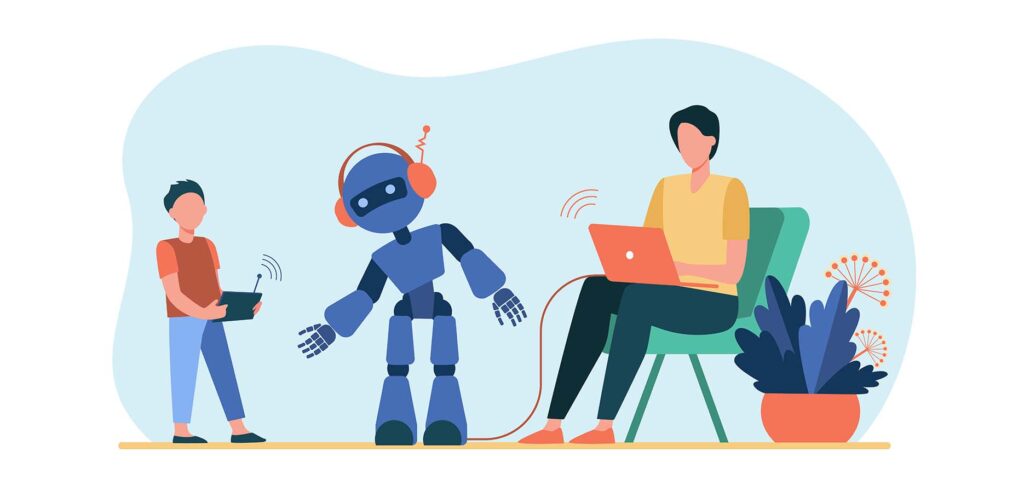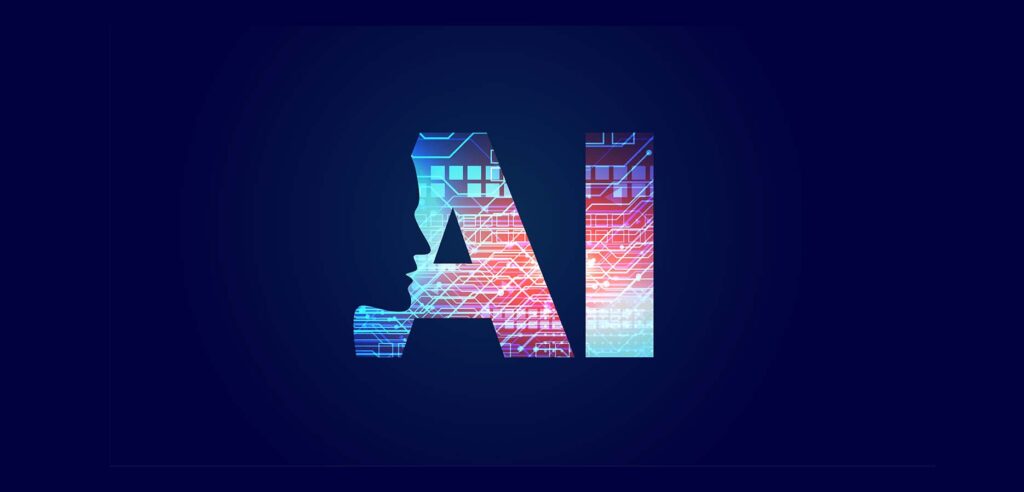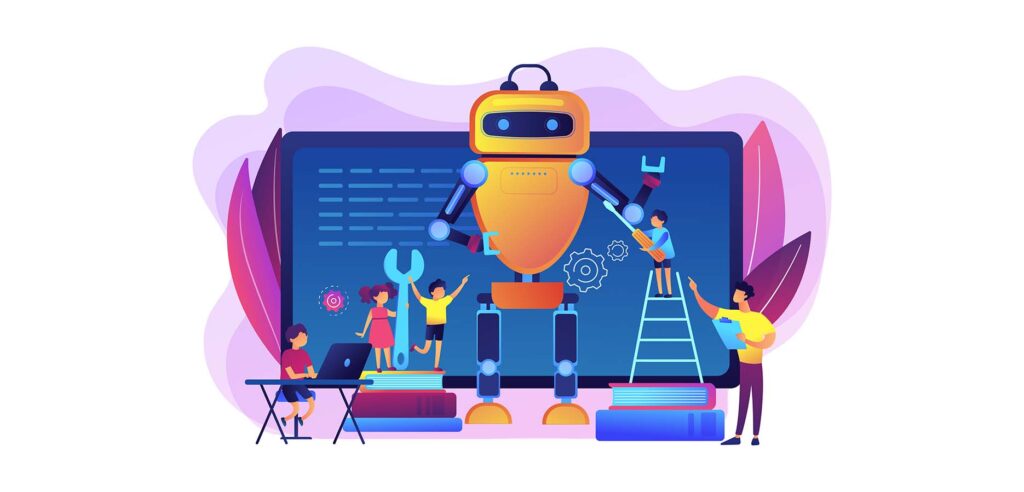Advancements in technology have revolutionized numerous sectors in society, education being one of them. Children are now being introduced to Artificial Intelligence (AI) in their learning journey, a concept that is innovative and fun. AI for kids is designed to enhance the learning experience by providing personalized education and boosting engagement, which is crucial in the digital era.
Key Takeaways
- AI for kids is a new concept in education that is designed to enhance the learning experience.
- AI technology provides personalized learning experiences, making it easier for children to grasp concepts and engage with the curriculum.
- AI-powered learning tools such as interactive apps, educational robots, and virtual tutors are available for children.
- AI can complement traditional educational approaches and promote a balanced learning environment.
- It is important to address ethical considerations such as privacy concerns, data protection, and algorithm bias when implementing AI in education.
What is AI for Kids?
AI for kids is the use of artificial intelligence technology in the context of children’s education. AI is a type of computer technology that mimics human intelligence and learns from data. By using AI in education, children are offered innovative and interactive learning experiences that can enhance their understanding of various subjects.
The application of AI for kids involves adapting the technology to suit the learning needs of children. This means developing AI-powered tools and platforms that are age-appropriate and engaging for kids. The use of AI in education is becoming more prevalent and is being integrated into various subjects, including math, science, language learning, and creative fields.
AI for kids is a new and exciting turn in the world of learning. It offers children a unique opportunity to interact with technology in a fun and educational way. By blending technology with traditional educational approaches, AI can provide personalized learning experiences that cater to children’s individual needs
Benefits of AI in Children’s Learning

Artificial Intelligence (AI) is revolutionizing the way kids learn. With its ability to understand and respond to individual student’s needs, AI can personalize the learning journey for each child, resulting in a more customized and engaging experience. The benefits of using AI in children’s education are numerous:
- Personalized learning experiences: AI can adapt to the student’s pace and style of learning, providing individualized support and feedback. This results in a more efficient and effective learning experience.
- Improved engagement: AI can create interactive and gamified learning experiences that keep kids motivated and excited about learning. This helps to increase student engagement and reduce boredom.
- Enhanced problem-solving skills: AI can challenge kids with complex problems and provide real-time feedback, helping to sharpen their critical thinking and problem-solving skills.
- Efficient grading and evaluation: AI-powered tools can automatically grade assignments, analyse data, and provide teachers with valuable insights into individual or group performance.
- Increased access to educational resources: AI can provide access to educational materials and resources that may be otherwise unavailable to some children, such as those living in remote or low-income areas.
Overall, AI can create a more personalized and engaging learning experience for children, helping them to develop the skills and competencies they need to succeed in the future. However, it is crucial to evaluate the ethical implications of using AI in education and ensure responsible usage to avoid any unwanted consequences.
AI-Powered Learning Tools for Kids

AI-powered learning tools have revolutionized the way children learn, offering a personalized and interactive learning experience that adapts to their individual needs. From educational robots to interactive apps and virtual tutors, AI-powered learning tools provide a range of exciting opportunities for kids to explore, discover, and learn.
One of the most popular AI-powered learning tools for kids is interactive apps. These apps are designed to be engaging, fun, and interactive, making learning feel like play. Many of these apps use AI to provide a personalized learning experience, adapting to the child’s individual needs and learning style. Some of the most popular educational apps for kids include ABC mouse, Duolingo, and ScratchJr.
Educational robots are another exciting AI-powered learning tool for kids. These robots are designed to engage children in hands-on learning experiences, encouraging creativity, critical thinking, and problem-solving skills. Some of the most popular educational robots for kids include Dash and Dot, Ozobot, and Sphero.
Virtual tutors are yet another AI-powered learning tool that is gaining popularity among kids. These tutors use natural language processing and machine learning algorithms to understand the child’s learning needs and provide personalized learning experiences. Virtual tutors like MEL Science and Knewton provide interactive and engaging learning experiences that help kids to learn faster and more effectively.
Overall, AI-powered learning tools offer a new and exciting way for kids to learn. With their personalized and interactive approach, these tools provide a fun and engaging learning experience that enhances children’s problem-solving skills, creativity, and critical thinking abilities.
AI in Language Learning for Kids

The use of AI in language learning has revolutionized the way children acquire new languages. AI-powered tools offer interactive and engaging learning experiences, tailored to the individual needs of each child.
Speech recognition technology, for example, allows kids to practice their language skills by interacting with virtual tutors. These tutors can recognize and correct pronunciation in real-time, providing immediate feedback and enhancing the learning process.
Moreover, AI-powered language translation tools and adaptive language learning platforms have made language learning more accessible and efficient than ever before. With the ability to translate text and speech instantly, children can communicate and learn in multiple languages without the need for a human translator.
The benefits of AI in language learning extend beyond language proficiency. AI-powered tools also improve cognitive abilities such as memory, attention, and problem-solving skills. By practicing language skills through interactive activities and games, children develop critical thinking skills and creativity.
Adaptive Language Learning Platforms
Adaptive language learning platforms are another example of how AI is transforming language education for kids. These platforms use machine learning algorithms to personalize the learning experience based on the child’s learning style, interests, and pace.
| Benefits of Adaptive Language Learning Platforms | |
|---|---|
| Personalized learning experiences | Gives students control over their own learning process. |
| Enhanced engagement | AI-powered activities and games make learning fun and interactive. |
| Faster language acquisition | Adaptive learning platforms accelerate the language learning process by tailoring to individual needs. |
By providing personalized feedback and adapting to the child’s learning progress, these platforms help children reach their full potential in language learning and beyond.
AI in Math Education for Kids

Mathematics is a subject that requires a strong foundation and understanding of core concepts to excel in. AI in math education for kids has the potential to provide a personalized learning experience tailored to the specific requirements of each student.
One of the primary benefits of AI in math education is the ability to adapt the learning pace and content to match the student’s level of understanding. AI-powered learning platforms can provide interactive and engaging learning experiences that help kids learn math in an intuitive way.
AI-powered tutors can also be used to provide students with one-on-one support, answering questions and providing feedback in real-time. These tutors can track progress and adjust the curriculum to suit the student’s learning pace, ensuring maximum retention of concepts.
Another innovative use of AI in math education for kids is gamification. Educational games can help students visualize mathematical concepts and apply them in problem-solving scenarios. This approach can help develop critical thinking and problem-solving skills that are essential for success in the subject and beyond.
Overall, AI in math education for kids has the potential to revolutionize the way students learn this subject, making it more engaging and personalized. By leveraging AI, students can develop a deeper understanding of core concepts and enhance their mathematical abilities.
AI in Science Education for Kids

Incorporating AI into science education for kids provides a wealth of opportunities to enhance the learning experience. With AI-powered simulations, interactive experiments, and virtual laboratories, children can explore complex scientific concepts in a safe and engaging environment.
AI also provides adaptive learning solutions that cater to each child’s unique learning style. With personalized feedback and recommendations, children can focus on areas where they need more practice and improve their scientific understanding.
One of the most exciting applications of AI in science education for kids is the use of robotics. Educational robots such as the Ozobot and the Sphero are designed to introduce children to robotics and coding in a fun and interactive way. Children can learn programming concepts and apply their knowledge to make robots perform specific tasks.
AI-Powered Laboratories and Simulations
Virtual laboratories and AI-driven simulations are effective ways to introduce children to complex scientific concepts. These platforms allow children to experiment with different variables and explore cause-and-effect relationships in a safe and controlled environment. For example, AI-powered simulations can help children understand the effects of climate change on ecosystems or explore the properties of chemical reactions.
AI-powered simulations also provide children with instant feedback, enabling them to learn from their mistakes and adjust their approach accordingly. By simulating real-world scenarios, children can develop their problem-solving skills and critical thinking abilities in a fun and engaging way.
Interactive Learning Experiences
AI can also be used to create interactive learning experiences for children that make science education more accessible and engaging. Augmented reality apps, for example, allow children to explore science concepts in a 3D environment, enhancing their understanding of abstract concepts.
The use of gamification in science education is another innovative approach being introduced to encourage children to learn through play. AI-powered games can help children learn scientific concepts and develop their analytical thinking skills in an engaging and entertaining way. For instance, children can play games that incorporate physics concepts such as trajectories, gravity, and velocity to solve challenges.
Overall, AI has a significant role to play in science education for kids. With its adaptive learning solutions, robotics, simulations, and interactive learning experiences, AI can help children develop a lifelong love of science while enhancing their problem-solving skills and critical thinking abilities.
AI in Creative Learning for Kids
AI is not limited to traditional subjects like math and science. It has also found its way into creative learning experiences for kids, sparking their imagination and promoting innovation. Here are some examples of how AI is integrated into creative subjects:
| Subject | AI Application |
|---|---|
| Art | AI-generated artwork, where algorithms are used to create unique pieces of art. Children can experiment with different parameters to create their own unique works of art. |
| Music | AI-assisted music composition, where kids can use AI to help them compose their own music. AI can suggest melodies, harmonies, and rhythms, helping children create their own unique compositions. |
| Storytelling | AI-powered chatbots that can engage in conversations with children, fostering their creativity and imagination. Children can also use AI to create their own interactive stories, where the plot twists and characters adapt to their choices. |
AI not only enhances the learning experience for creative subjects but also promotes critical thinking and problem-solving skills. By using AI as a tool, children can explore and experiment with new techniques and ideas, fostering a lifelong love of the arts.
Ethical Considerations in AI for Kids
As with any form of technology, the use of AI in children’s education raises ethical considerations that must be addressed. While AI can bring numerous benefits and improve the learning experience, it is important to ensure that its use is responsible and ethical.
One of the key ethical considerations in the use of AI in education is privacy. Children’s data must be protected and kept secure, and there must be transparency around how this data is collected, stored, and used. Additionally, there is a risk that AI algorithms may be biased or reinforce existing stereotypes, which could result in discrimination against certain groups of children. It is important to monitor and mitigate these risks and ensure that AI is used in a fair and unbiased way.
Another ethical consideration in the use of AI in education is the digital divide. Not all children have equal access to technology, which could result in some children being left behind if AI is used in the classroom. It is important to ensure that AI does not exacerbate existing inequalities and that all children have access to the technology needed to benefit from its use. Additionally, there is a risk that children become overly reliant on AI, which could impact their ability to learn and problem-solve independently. It is important to strike a balance between the use of AI and traditional educational approaches to ensure that children receive a well-rounded education.
To address these ethical considerations, it is important for educators and institutions to have clear guidelines and policies in place for the use of AI in children’s education. Additionally, there should be ongoing monitoring and evaluation of the use of AI to ensure that it is being used in an ethical and responsible way. By addressing these considerations, we can ensure that the use of AI in children’s education is a positive and transformative force.
Challenges and Limitations of AI for Kids

While AI for kids presents exciting possibilities, it also comes with its own set of challenges and limitations. Educators and parents need to be mindful of these issues to ensure responsible use of AI in children’s education.
Digital Divide
One of the most significant challenges of AI for kids is the digital divide. Not all children have access to the same technology, so some may miss out on the benefits of AI-powered learning experiences. This issue emphasizes the need for equitable access to technology and resources.
Technology Dependency
Another challenge is the potential for children to become overly reliant on AI technology. While AI can enhance learning, it cannot replace the importance of human interaction and support. Educators and parents must find a balance between utilizing AI and fostering face-to-face communication.
Human Connection
AI technology can also create a barrier to human connection. Children need social interaction and emotional support to develop essential skills such as empathy and communication. It is crucial to ensure that AI technology is used to complement, rather than replace, human interaction.
Ethical Considerations
Finally, there are ethical considerations to keep in mind when using AI for kids. These include privacy concerns, data protection, and algorithm bias. Educators and parents must ensure that AI-powered learning experiences are designed with ethical principles in mind, and that children’s data is protected.
Parental Involvement in AI for Kids
While AI technology has the potential to revolutionize children’s education, parents play an essential role in supporting their children’s learning journey. Here are some tips for parents to maximize the benefits of AI in education:
- Stay involved in your children’s learning process and ask them about what they are learning with AI-powered tools. This helps you understand their progress and challenges.
- Encourage a balanced approach to learning, combining both AI-powered tools and traditional educational methods.
- Ensure that your child’s personal information is protected and that their data is not being used inappropriately, following all privacy regulations and guidelines.
- Support your child in creating a healthy relationship with technology and ensuring they are not overly dependent on AI-powered tools.
- Provide opportunities for your child to apply their newfound knowledge and skills to real-world situations.
- Stay informed of the latest developments in AI for education and be open to exploring new AI-powered learning tools with your child.
By taking an active role in their children’s learning journey with AI, parents can help ensure that their children are getting the most out of this innovative technology.
AI and Traditional Education: A Balanced Approach
While AI has the potential to revolutionize the way we approach education, it is important to maintain a balanced approach that combines both AI and traditional methods of learning. Traditional education emphasizes critical thinking, creativity, and interpersonal skills, which are essential for success in any field. However, AI can supplement these methods by providing personalized learning experiences and enhancing problem-solving skills.
Integrating AI into traditional education requires thoughtful planning and implementation. It is essential to identify specific areas where AI can enhance learning outcomes and align them with the objectives of the curriculum. Additionally, educators must be trained to use AI tools effectively and guide students in their learning journey.
One way to strike a balance between AI and traditional education is to use AI as a tool to supplement the existing curriculum. For example, AI-powered adaptive learning platforms can provide students with additional study materials and personalized quizzes based on their learning needs. AI-powered virtual tutors can answer questions and provide feedback to students, while AI-driven simulations can enhance students’ understanding of complex scientific concepts.
By leveraging the strengths of both traditional education and AI, we can create a learning environment that nurtures both creativity and technological literacy. With careful planning and implementation, we can make sure that AI is used in a responsible and effective way to enhance the learning journey of children in this new digital era.
AI for Kids: Future Possibilities

The potential for AI in children’s education is vast and evolving. As technology continues to advance, so do the possibilities for AI-powered learning experiences for kids.
Personalized Learning Algorithms
One potential development in AI for kids is the creation of personalized learning algorithms that adapt to each child’s unique learning style and pace. These algorithms could analyze a child’s progress and adjust the content and difficulty level of the material accordingly.
Virtual Reality Integration
Virtual reality integration is another exciting possibility for AI in education. With the use of virtual reality technology, children could explore immersive environments and interact with realistic simulations to enhance their understanding of complex concepts.
AI-Driven Educational Content
AI technology could also be used to generate educational content, such as textbooks, assignments, and quizzes. These materials could be tailored to meet the specific needs of each student, making learning more enjoyable and effective.
Overall, the future of AI in kids’ education holds great promise. With the right development and implementation, AI could revolutionize the way children learn and help prepare them for success in the digital era.
Implementing AI for Kids: Best Practices
Integrating AI into children’s education requires careful planning and execution. To ensure the successful implementation of AI in the classroom, here are some best practices to consider:
- Define clear learning objectives: Determine the specific learning outcomes that you want students to achieve using AI. Align these objectives with your school’s curriculum and learning goals.
- Choose appropriate AI-powered tools: There is a wide variety of AI-powered learning tools available, from virtual assistants to adaptive learning software. Choose the ones that best fit your learning objectives and the individual needs of your students.
- Provide adequate teacher training: Teachers need to be trained on how to effectively use AI tools in the classroom. Provide professional development opportunities and ongoing support to ensure that teachers are comfortable with the technology.
- Ensure data privacy and security: Protect students’ data by implementing secure data storage and sharing protocols. Ensure that the AI tools you use conform to data protection regulations.
- Monitor student progress: Use AI tools to track student progress and adjust the learning experience accordingly. This will help you to identify areas for improvement and ensure that students are meeting their learning objectives.
By implementing these best practices, you will ensure that AI is used effectively and responsibly in the classroom, promoting a positive and productive learning experience for all students.
The Role of AI in Shaping the Next Generation
The 21st century has brought with it new challenges and opportunities for the next generation. With technology advancing at an unprecedented pace, the role of Artificial Intelligence (AI) in shaping the future workforce cannot be ignored. As society moves towards a more digitally-focused era, AI has the potential to transform the skills and competencies required for success.
One of the most significant ways AI can shape the next generation is by providing personalized learning experiences. By leveraging AI algorithms, students can receive tailored instruction based on their individual learning pace and style. This allows for a more efficient use of time and resources and can help to bridge the achievement gap.
Another way in which AI can shape the next generation is by promoting the development of 21st-century skills. These skills, including critical thinking, problem-solving, and collaboration, are essential for success in the modern workforce. AI-powered tools and platforms can provide opportunities for students to practice and develop these skills in engaging and interactive ways.
AI can also help to create a more equitable education system. By providing access to quality education to those who would otherwise be excluded due to geographic or socioeconomic barriers, AI can help reduce the digital divide and promote social mobility.
However, it is essential to consider the ethical considerations of AI usage in education. Algorithm bias and data protection are some of the issues that need to be addressed to ensure that AI is used responsibly. Educators and policymakers need to work together to create guidelines and regulations to ensure that AI is used ethically and with the best interests of students in mind.
Overall, the role of AI in shaping the next generation cannot be underestimated. By providing personalized learning experiences, promoting the development of 21st-century skills, and creating a more equitable education system, AI has the potential to transform the way we educate our children. However, it is important to use AI thoughtfully and responsibly, ensuring that it is leveraged to create a better, more inclusive education system for all.
Conclusion
AI for kids is transforming the world of learning in this digital era. Its innovative and fun aspects have made learning engaging and personalized, and its applications in various educational fields such as language, math, science, and creativity have improved children’s problem-solving abilities and enhanced their skills.
However, as with any emerging technology, AI for kids presents ethical considerations, challenges, and limitations that must be considered to ensure responsible usage. This includes issues such as privacy concerns, data protection, algorithm bias, and technology dependency.
Despite these challenges, the potential benefits of AI for children’s education are significant. It can complement traditional educational approaches and promote a balanced learning environment that fosters creativity, curiosity, and critical thinking. Best practices for implementing AI in children’s education include thoughtful curriculum design, teacher training, and evaluation.
Overall, AI has the potential to shape the learning journey of the next generation and contribute to a future-ready workforce. It is essential to leverage AI for educational purposes while addressing ethical considerations to ensure a positive impact on children’s learning journey in this new digital era.
FAQ
Q: What is AI for Kids?
A: AI for Kids refers to the use of Artificial Intelligence technology in the context of children’s education. It involves the development and implementation of AI-powered learning tools and platforms that cater to the specific needs and learning styles of children.
Q: What are the benefits of AI in children’s learning?
A: AI offers several advantages in children’s learning, including personalized learning experiences, improved engagement, and enhanced problem-solving skills. It can adapt to each child’s unique abilities and provide tailored education that promotes individual growth and development.
Q: What are the AI-powered learning tools available for kids?
A: There are various AI-powered learning tools for kids, such as interactive apps, educational robots, and virtual tutors. These tools leverage AI technology to create engaging and interactive learning experiences that enhance children’s understanding and retention of educational concepts.
Q: How is AI utilized in language learning for kids?
A: AI is utilized in language learning for kids through features like speech recognition, language translation, and adaptive language learning platforms. These AI-driven tools assist children in improving their language acquisition skills by providing real-time feedback and personalized learning experiences.
Q: What role does AI play in math education for kids?
A: AI plays a significant role in math education for kids by offering adaptive learning platforms, AI-powered tutors, and gamified learning experiences. These AI-driven tools provide personalized math instruction, tailored practice exercises, and interactive games that make learning math engaging and effective.
Q: How does AI contribute to science education for kids?
A: AI contributes to science education for kids through applications such as virtual laboratories, AI-driven simulations, and interactive learning experiences. These AI-powered tools provide hands-on experimentation, visual representations of scientific concepts, and immersive learning opportunities that enhance children’s understanding of science.
Q: How is AI integrated into creative learning for kids?
A: AI is integrated into creative learning for kids through AI-generated artwork, music composition, and storytelling. These AI-driven tools spark children’s creativity and imagination by offering new possibilities and enabling them to explore their artistic and storytelling abilities in innovative ways.
Q: What are some ethical considerations in AI for kids?
A: Some ethical considerations in AI for kids include privacy concerns, data protection, and algorithm bias. It is essential to ensure responsible AI usage, safeguard children’s personal information, and address any potential biases that may arise in AI algorithms.
Q: What are the challenges and limitations of AI for kids?
A: Some challenges and limitations of AI for kids include the digital divide, technology dependency, and potential disconnect from human interaction. It is necessary to address these issues to ensure equitable access to AI tools, maintain a balanced approach to education, and promote healthy social interactions.
Q: What is the role of parental involvement in AI for kids?
A: Parental involvement plays a vital role in supporting and guiding children’s AI-powered learning experiences. Parents can collaborate with educators, monitor their children’s progress, provide additional guidance, and ensure a healthy balance between screen time and other activities.
Q: How can AI and traditional education be balanced?
A: AI can complement traditional educational approaches by providing personalized learning experiences, automating administrative tasks, and enhancing educational resources. It is important to integrate AI thoughtfully into existing educational systems, ensuring that it supports and enhances the overall learning experience.
Q: What are the future possibilities of AI for kids?
A: The future possibilities of AI for kids include personalized learning algorithms, virtual reality integration, and AI-driven educational content. These advancements have the potential to revolutionize children’s education, offering tailored instruction and immersive learning experiences.
Q: What are the best practices for implementing AI for kids?
A: Best practices for implementing AI for kids include considerations for curriculum design, teacher training, and evaluation. Educators and institutions should ensure that AI technologies align with educational goals and are effectively integrated into the learning environment.
Q: What is the role of AI in shaping the next generation?
A: AI has the potential to shape the skills and competencies of the next generation by promoting critical thinking, problem-solving, and collaboration. It can contribute to a future-ready workforce that is equipped with the necessary skills to thrive in an AI-driven world.
- What is AI for Kids?
- Benefits of AI in Children’s Learning
- AI-Powered Learning Tools for Kids
- AI in Language Learning for Kids
- AI in Math Education for Kids
- AI in Science Education for Kids
- AI in Creative Learning for Kids
- Ethical Considerations in AI for Kids
- Challenges and Limitations of AI for Kids
- Parental Involvement in AI for Kids
- AI and Traditional Education: A Balanced Approach
- AI for Kids: Future Possibilities
- Implementing AI for Kids: Best Practices
- The Role of AI in Shaping the Next Generation
- Conclusion
- FAQ

AI for Kids: A New Turn in the World of Learning